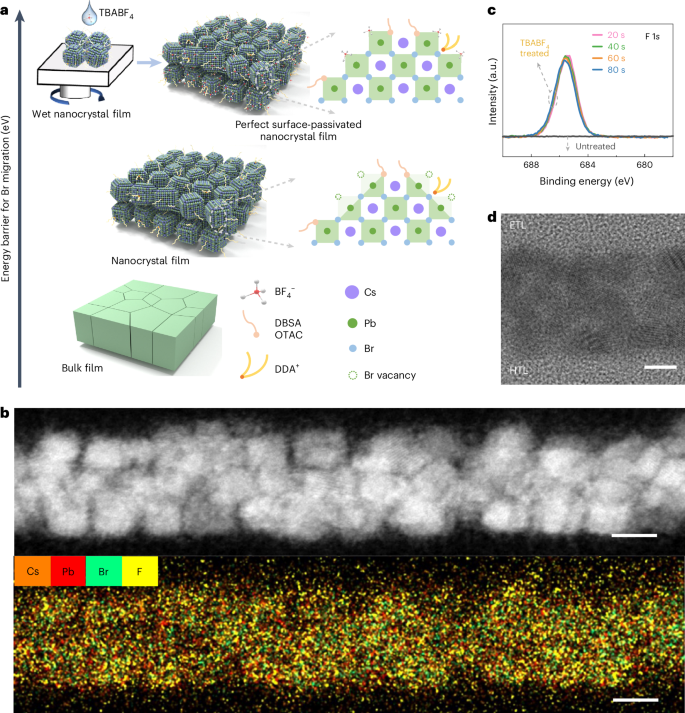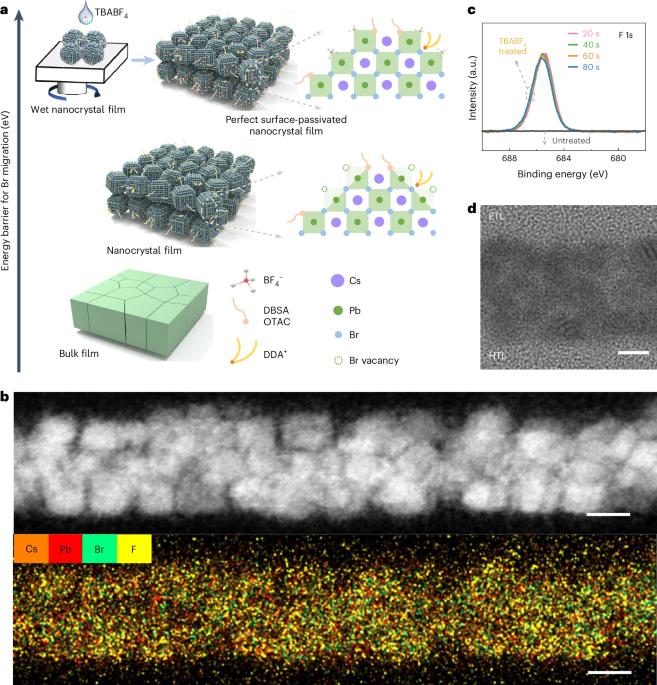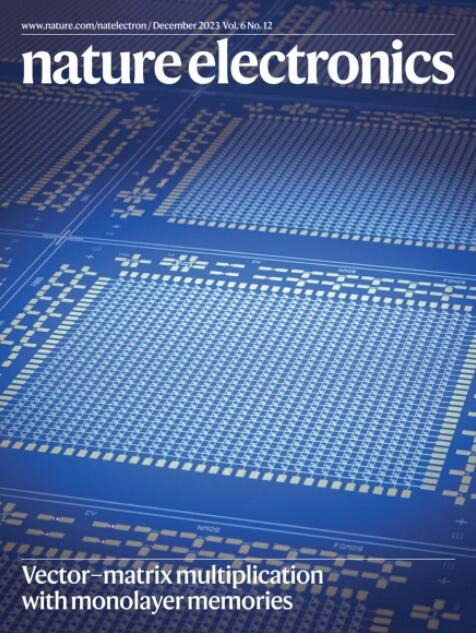用于有源矩阵显示器的微秒级响应过氧化物发光二极管
IF 33.7
1区 工程技术
Q1 ENGINEERING, ELECTRICAL & ELECTRONIC
引用次数: 0
摘要
透镜发光二极管(PeLED)可用于开发有源矩阵显示器。然而,由于晶体结构中的离子迁移,PeLED 的电致发光上升时间超过几毫秒,这对于开发高刷新率显示器来说是个问题。在这里,我们展示了利用单个粒子钝化策略可将 PeLED 的电致发光上升时间缩短到微秒级。这种方法基于 BF4 离子,它可以在薄膜沉积过程中钝化过氧化物发光层中的每个纳米晶体。这种方法能生成具有离散纳米结构和优异结晶度的无缺陷薄膜,从而抑制离子迁移。我们的策略可应用于不同颜色的过氧化物纳米晶体薄膜:红色(635 纳米)、绿色(520 纳米)和蓝色(475 纳米)。这些 PeLED 的响应时间都在微秒以内,外部量子效率分别达到 22.7%、26.2% 和 18.1%。这使我们能够制造出微秒级响应的有源矩阵 PeLED,在显示亮度为 500-3000 cd m-2 时,外部量子效率超过 20%,适用于分辨率为每英寸 30 像素的绿色设备。我们还开发了每英寸 90 像素的微秒响应红、绿、蓝有源矩阵显示器。本文章由计算机程序翻译,如有差异,请以英文原文为准。


Microsecond-response perovskite light-emitting diodes for active-matrix displays
Perovskite light-emitting diodes (PeLEDs) could be of use in the development of active-matrix displays. However, due to ion migration in crystal structure, PeLEDs have electroluminescence rise times over milliseconds, which is problematic for the development of high-refresh-rate displays. Here, we show that the electroluminescence rise time of PeLEDs can be reduced to microseconds using an individual-particle passivation strategy. The approach is based on BF4− ions that can passivate every nanocrystal in a perovskite emissive layer during film deposition. It leads to a defect-free film with discrete nanostructure and excellent crystallinity, which inhibits ion migration. Our strategy can be applied in perovskite nanocrystal films with different colours: red (635 nm), green (520 nm) and blue (475 nm). These PeLEDs all demonstrate response times within microseconds and high external quantum efficiencies of 22.7%, 26.2% and 18.1%, respectively. This allows us to create microsecond-response active-matrix PeLEDs that exhibit external quantum efficiencies above 20% at a display brightness of 500–3,000 cd m−2 for green devices with a resolution of 30 pixels per inch. We also develop microsecond-response red, green and blue active-matrix displays with 90 pixels per inch. An individual-particle passivation strategy that reduces ion migration in perovskite nanocrystal film can be used to make high-refresh-rate active-matrix displays with microsecond response times reduced by three orders of magnitude compared with typical perovskite light-emitting diodes.
求助全文
通过发布文献求助,成功后即可免费获取论文全文。
去求助
来源期刊

Nature Electronics
Engineering-Electrical and Electronic Engineering
CiteScore
47.50
自引率
2.30%
发文量
159
期刊介绍:
Nature Electronics is a comprehensive journal that publishes both fundamental and applied research in the field of electronics. It encompasses a wide range of topics, including the study of new phenomena and devices, the design and construction of electronic circuits, and the practical applications of electronics. In addition, the journal explores the commercial and industrial aspects of electronics research.
The primary focus of Nature Electronics is on the development of technology and its potential impact on society. The journal incorporates the contributions of scientists, engineers, and industry professionals, offering a platform for their research findings. Moreover, Nature Electronics provides insightful commentary, thorough reviews, and analysis of the key issues that shape the field, as well as the technologies that are reshaping society.
Like all journals within the prestigious Nature brand, Nature Electronics upholds the highest standards of quality. It maintains a dedicated team of professional editors and follows a fair and rigorous peer-review process. The journal also ensures impeccable copy-editing and production, enabling swift publication. Additionally, Nature Electronics prides itself on its editorial independence, ensuring unbiased and impartial reporting.
In summary, Nature Electronics is a leading journal that publishes cutting-edge research in electronics. With its multidisciplinary approach and commitment to excellence, the journal serves as a valuable resource for scientists, engineers, and industry professionals seeking to stay at the forefront of advancements in the field.
 求助内容:
求助内容: 应助结果提醒方式:
应助结果提醒方式:


